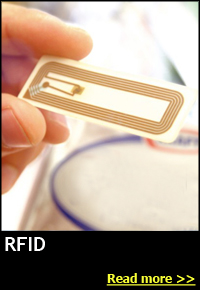
RFID
Radio-frequency identification (RFID) is an automatic identification method, relying on storing and remotely retrieving data using devices called RFID tags or transponders. The technology requires some extent of cooperation of an RFID reader and an RFID tag.
An RFID tag is an object that can be applied to or incorporated into a product, animal, or person for the purpose of identification and tracking using radio waves. Some tags can be read from several meters away and beyond the line of sight of the reader.
Most RFID tags contain at least two parts. One is an integrated circuit for storing and processing information, modulating and demodulating a radio-frequency (RF) signal, and other specialized functions. The second is an antenna for receiving and transmitting the signal.
There are generally two types of RFID tags: active RFID tags, which contain a battery, and passive RFID tags, which have no battery.
Future Chipless RFID allows for discrete identification of tags without an integrated circuit, thereby allowing tags to be printed directly onto assets at a lower cost than traditional tags. As of 2008 none of the chipless concepts has become operational.
Today, RFID is used in enterprise supply chain management to improve the efficiency of inventory tracking and management.
